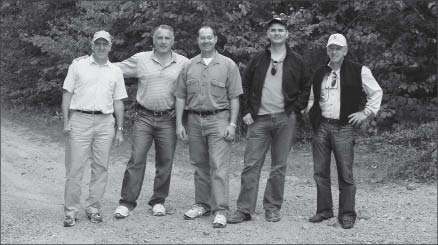When Pele Mountain Resources (GEM-V) completed a scoping study in 2007 on its Eco Ridge mine project in Elliot Lake, Ont., the company didn’t even bother to include the deposit’s rare earth elements as a byproduct of the project’s planned uranium production.
“The primary driver of this project was uranium,” Al Shefsky, Pele Mountain’s president and chief executive, explains in a telephone interview. “What changed is that the price of rare earth elements (REEs) has gone vertical and they can potentially provide a significant component of our economic model.”
Eco Ridge contains three times as much rare earth oxide as it does uranium oxide (U3O8), he says, adding that the company has released a new resource estimate and plans to update a preliminary assessment looking at combined revenues from uranium oxide and REEs.
According to the updated resource estimate released in late February, Eco Ridge has indicated resources of 51.9 million lbs. of total rare earth oxides (TREO) (14.31 million tonnes grading 0.16% TREO) plus a further 96.3 million lbs. of TREOs in the inferred category (33.12 million tonnes at 0.13% TREO).
These resources are in addition to the 15.2 million lbs. U3O8 the deposit contains in the indicated category (14.31 million tonnes at 0.048% U3O8) and the 31.44 million lb. U3O8 in the inferred category (33.12 million tonnes at 0.043% U3O8).
The REE resource estimate was based on 123 drill holes, while the U3O8 resource estimate was based on 237 drill holes, 152 of which were drilled by Pele Mountain between 2006 and 2009, and 85 of which were historic holes drilled between 1954 and 1974.
Eco Ridge contains the full range of REEs, including the more valuable “heavy” REEs, or HREEs. Although yttrium and heavy REEs make up a minority of the deposit’s overall rare earth element content, Shefsky says, they have better recovery rates than the light REEs, or LREEs.
“The heavies are by far the minority of the overall head grade but of what is recoverable, we’ll have close to 50% of heavies plus yttrium,” he maintains. “We also have scandium, which is an interesting element that is in limited supply.”
While the REEs are a nice addition to the Eco Ridge project, uranium remains the main focus and Shefsky sees uranium prices moving higher as the world tries to wean itself off oil.
“For a couple of years the price of uranium was flat at about US$40 per lb. and this deposit, frankly, wouldn’t work at US$40 per lb. so it was a difficult time for us, but we always believed that the fundamentals of supply and demand meant that that price would go higher,” he says.
“If you look at all the uranium produced in the world and what is needed, there is already a shortage… and you’ve got all these new nuclear reactors being built.
“We see what’s happening in the Middle East. The world is addicted to this oil that is coming from these very unstable regions, and if we want energy security, we’re going to have to build a lot more nuclear reactors… this nuclear renaissance is only going to continue to gather steam.”
Pele Mountain plans to develop the Eco Ridge project as an underground uranium mine with a surface processing plant about 11 km east of the city of Elliot Lake. It also plans to develop the project using a combination of underground bio-leaching and surface heap leaching which it says will have a much smaller environmental impact. The method was used by previous uranium mines in the area before they were shut down in the 1990s due to collapsing uranium prices.
The mine plan envisions about 60% of the rock being treated through underground bio-leaching. “The ore will be sealed off (underground) and then flooded with water,” he explains. “When the water comes into contact with the ore it creates an acidic environment and in that environment, the uranium and REEs readily leach into solution.”
The resulting solution, pregnant with uranium oxides and REE oxides, is then brought to surface and sent through a solvent extraction processing plant to remove the uranium. Effluent from that processing plant would then be sent through a REE recovery plant and a second solvent extraction plant will remove the rare earth oxides and create a mixed concentrate on site.
The remaining 35% of the ore that was mined and brought to surface and put on a heap-leach pad will go through a closed circuit and then combined with the solutions from underground until it reaches a certain concentration, Shefsky explains.
“It’s a really good approach because we don’t have liquid effluents going into the environment that require further treatment,” he says. “It is better than having the tailings ponds and dams that they did in the past.
“The fact that it is well-established and has been used to recover a significant amount of uranium in the past proves that it works,” he says of underground bio-leaching. “Maybe not a lot of people are familiar with it, but those who understand what’s been done in Elliot Lake won’t be surprised at all that it’s going to be done again. It’s an effective way of recovering uranium.”
In its heyday Elliott Lake was known as the “uranium capital of the world.” Pele Mountain estimates that between 1956 and 1996 companies like Rio Algom and Denison Mines produced a total of about 300 million lbs. of U3O8. Rio Algom’s Stanleigh mine was the last to close in 1996.
News of Pele’s updated resource estimate sent the company’s shares up 3.5¢ to close at 49¢ per share on 6.3 million shares traded.
Over the last year, it has traded between a low of 8.5¢ per share (July 20, 2010) and a high of 69¢ per share (Jan. 24, 2011). The company has 132 million shares outstanding.


Be the first to comment on "Pele Mountain adds REEs to the mix"